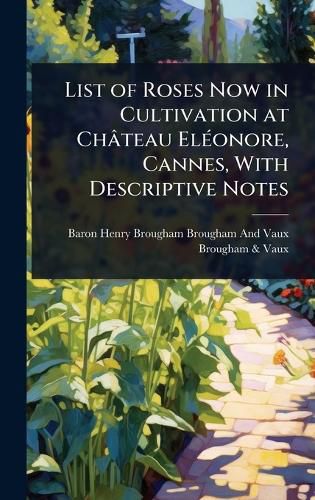Readings Newsletter
Become a Readings Member to make your shopping experience even easier.
Sign in or sign up for free!
You’re not far away from qualifying for FREE standard shipping within Australia
You’ve qualified for FREE standard shipping within Australia
The cart is loading…






This title is printed to order. This book may have been self-published. If so, we cannot guarantee the quality of the content. In the main most books will have gone through the editing process however some may not. We therefore suggest that you be aware of this before ordering this book. If in doubt check either the author or publisher’s details as we are unable to accept any returns unless they are faulty. Please contact us if you have any questions.
Discover a fascinating glimpse into the world of rose cultivation in the 19th century with "List of Roses Now in Cultivation at Chateau ElA(c)onore, Cannes, With Descriptive Notes." This meticulously compiled list, originating from the renowned Chateau ElA(c)onore in Cannes, offers a detailed inventory of the rose varieties thriving in its gardens.
Compiled by Baron Henry Brougham Brougham and Vaux, this book provides more than just a catalogue; it includes descriptive notes that offer insights into the characteristics of each rose. Whether you are a seasoned horticulturist, a rose enthusiast, or a historian of gardens, this book will provide a valuable snapshot of the floral treasures of a bygone era. Explore the varieties that captivated the gardens of Chateau ElA(c)onore and gain a deeper appreciation for the art and science of rose cultivation.
This work has been selected by scholars as being culturally important, and is part of the knowledge base of civilization as we know it. This work was reproduced from the original artifact, and remains as true to the original work as possible. Therefore, you will see the original copyright references, library stamps (as most of these works have been housed in our most important libraries around the world), and other notations in the work.
This work is in the public domain in the United States of America, and possibly other nations. Within the United States, you may freely copy and distribute this work, as no entity (individual or corporate) has a copyright on the body of the work.
As a reproduction of a historical artifact, this work may contain missing or blurred pages, poor pictures, errant marks, etc. Scholars believe, and we concur, that this work is important enough to be preserved, reproduced, and made generally available to the public. We appreciate your support of the preservation process, and thank you for being an important part of keeping this knowledge alive and relevant.
$9.00 standard shipping within Australia
FREE standard shipping within Australia for orders over $100.00
Express & International shipping calculated at checkout
This title is printed to order. This book may have been self-published. If so, we cannot guarantee the quality of the content. In the main most books will have gone through the editing process however some may not. We therefore suggest that you be aware of this before ordering this book. If in doubt check either the author or publisher’s details as we are unable to accept any returns unless they are faulty. Please contact us if you have any questions.
Discover a fascinating glimpse into the world of rose cultivation in the 19th century with "List of Roses Now in Cultivation at Chateau ElA(c)onore, Cannes, With Descriptive Notes." This meticulously compiled list, originating from the renowned Chateau ElA(c)onore in Cannes, offers a detailed inventory of the rose varieties thriving in its gardens.
Compiled by Baron Henry Brougham Brougham and Vaux, this book provides more than just a catalogue; it includes descriptive notes that offer insights into the characteristics of each rose. Whether you are a seasoned horticulturist, a rose enthusiast, or a historian of gardens, this book will provide a valuable snapshot of the floral treasures of a bygone era. Explore the varieties that captivated the gardens of Chateau ElA(c)onore and gain a deeper appreciation for the art and science of rose cultivation.
This work has been selected by scholars as being culturally important, and is part of the knowledge base of civilization as we know it. This work was reproduced from the original artifact, and remains as true to the original work as possible. Therefore, you will see the original copyright references, library stamps (as most of these works have been housed in our most important libraries around the world), and other notations in the work.
This work is in the public domain in the United States of America, and possibly other nations. Within the United States, you may freely copy and distribute this work, as no entity (individual or corporate) has a copyright on the body of the work.
As a reproduction of a historical artifact, this work may contain missing or blurred pages, poor pictures, errant marks, etc. Scholars believe, and we concur, that this work is important enough to be preserved, reproduced, and made generally available to the public. We appreciate your support of the preservation process, and thank you for being an important part of keeping this knowledge alive and relevant.